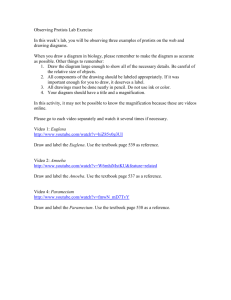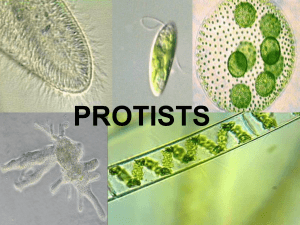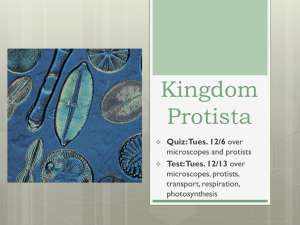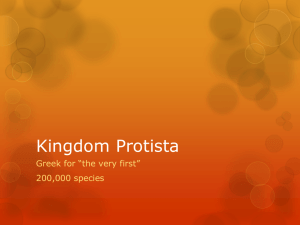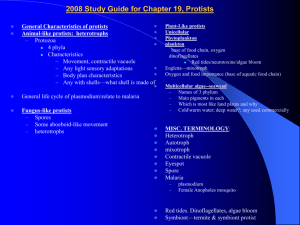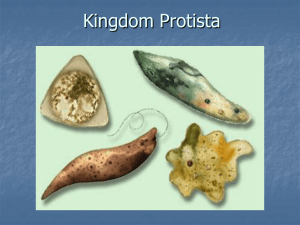food vacuole
advertisement
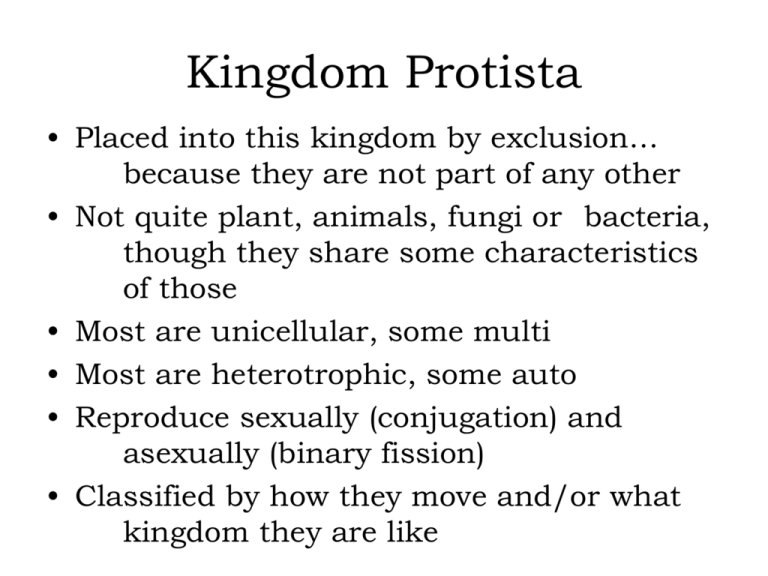
Kingdom Protista • Placed into this kingdom by exclusion… because they are not part of any other • Not quite plant, animals, fungi or bacteria, though they share some characteristics of those • Most are unicellular, some multi • Most are heterotrophic, some auto • Reproduce sexually (conjugation) and asexually (binary fission) • Classified by how they move and/or what kingdom they are like Animal-like protists • Also called protozoa • Live in water/moist soil and feed on smaller organisms (bacteria, protists) • Phylum protozoa – Amoeboid movement…cytoplasm moves forward in a pseudopod (false foot) and pulls rest of body that way – e.g. amoeba, foraminiferans, radiolarians – e.g. Entamoeba histolytica…amebiasis Amoeba Radiolarians Foraminiferans Animal-like protists • Phylum Ciolophora – Move by cilia…small hairs that beat in rhythm – Cilia move food into an oral groove that ends in a food vacuole – Remove water from cell by contractile vacuole – 2 nuclei: • Macronucleus…controls functions • Micronucleus…used during conjugation Paramecium Paramecium reproduction Paramecia conjugating: http://www.youtube.com/wat ch?v=5c_Vhb0vBVw Animal-like protists • Phylum Sarcomastigophora – Move by flagella…long whip like tail – e.g. trypanosome (African Sleeping Sickeness), Giardiasis, Trichomoniasis • Phylum Apicomplexa – Don’t move, all are parasites – Named for apical complex…specialized structures used to enter host – e.g. toxoplasma, cryptosporidium, plasmodium (malaria) Trypanosome (sleeping sickness) Plasmodium (malaria) Plant-like protists • All are autotrophic and photosynthetic • Most live in water and have a flagellum at some point in their life • Algae…classified by pigments used for photosynthesis and color – – – – – Green algae: what you think of as “algae” Brown algae: seaweed and kelp Diatoms: live in soil Dinoflagelates: bioluminesce (make own light) Euglenoids: Euglenas: have a light detecting area called an eye spot. Dinoflagellates Euglena Euglena http://www.youtube.com/watc h?v=z01EUaUd3E4 Diatoms Spirogyra Volvox http://www.youtube.com/watch?v=w8O4Ool GcPg Fungus-like protists • Reproduce using spores contained in a fruiting body like fungi do • Slime molds and water molds Impact on humans • Good: – – – – – Create oxygen (plantlike)/carbon cycle Basis of food chain, especially aquatic Symbiotic relationships, e.g. coral colors Research: chemotaxis (cell movement) Food: seaweed • Bad: – Algae blooms: use up all oxygen – Diseases (specific ones mentioned earlier) Movies • Paramecia conjugating: http://www.youtube.com/watch?v=5c_Vhb0vBVw • Close up contractile vacuoule http://www.youtube.com/watch?v=iG6Dd3COug4 • Amoeba moving: http://www.youtube.com/watch?v=GRymTNuPi2M • Euglena http://www.youtube.com/watch?v=z01EUaUd3E4 • Volvox http://www.youtube.com/watch?v=w8O4OolGcPg • Amoeba eating http://wolfbat359.com/phagocytosis1.mov
